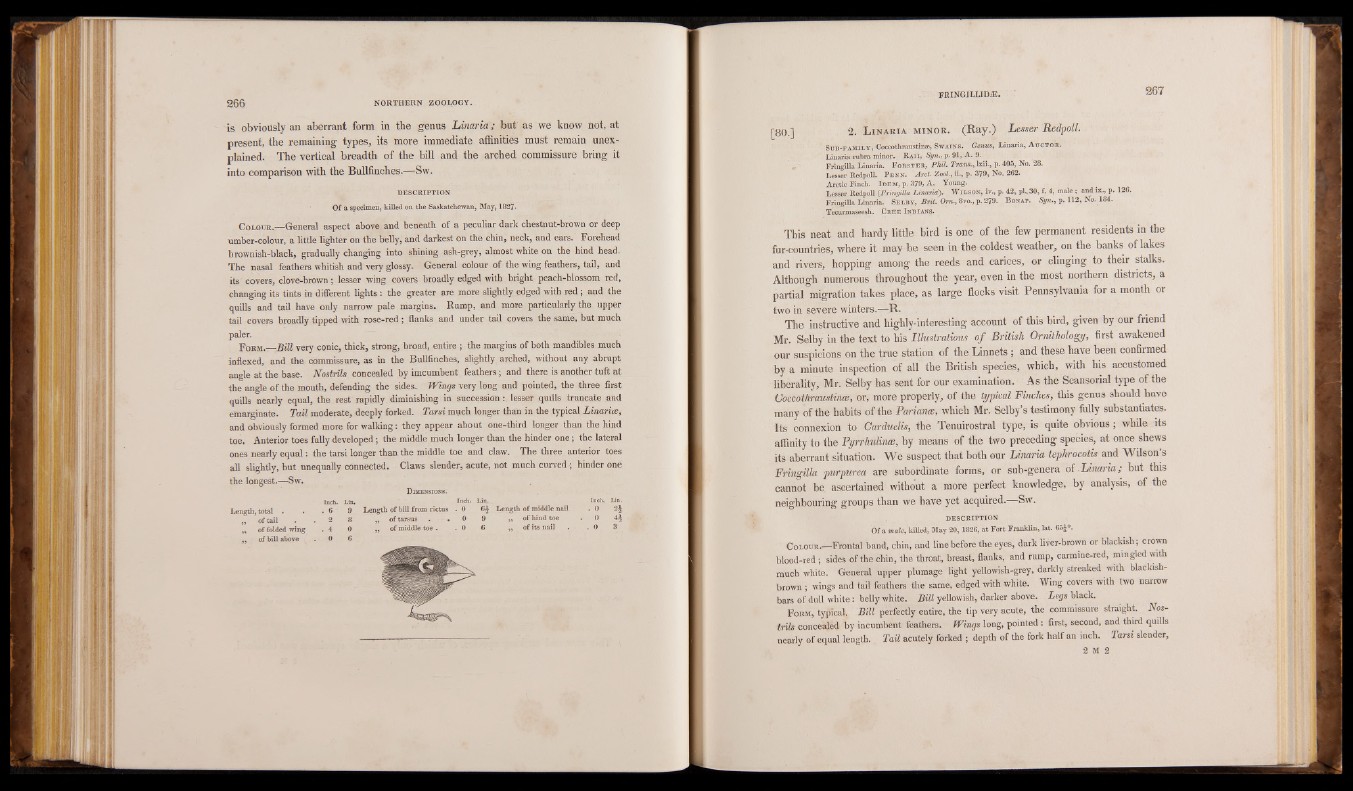
is obviously an aberrant form in the genus Linaria; but as we know not, at
present, the remaining types, its more immediate affinities must remain unexplained.
The vertical breadth of the bill and the arched commissure bring it
into comparison with the Bullfinches.—Sw.
DESCRIPTION
Of a specimen, killed on the Saskatchewan, May, 1827-
C o l o u r .— General aspect above and beneath of a peculiar dark chestnut-brown or deep
umber-colour, a little lighter on the belly, and darkest bn the chin, neck, and ears. Forehead
brownish-black, gradually changing into shining ash-grey, almost white on the hind head.
The nasal feathers whitish and very glossy. General colour of the wing feathers, tail, and
its covers, clove-brown; lesser wing covers broadly edged with bright peach-blossom red,
changing its tints in different lights : the greater are more slightly edged with red ; and the
quills and tail have only narrow pale margins. Rump, and more particularly the upper
tail covers broadly tipped with rose-red ; flanks and under tail covers the same, but much
paler.
Form.__Bill very conic, thick, strong, broad, entire ; the margins of both mandibles much
inflexed, and the commissure, as in the Bullfinches, slightly arched, without any abrupt
angle at the base. Nostrils concealed by imcumbent feathers; and there is another tuft at
the angle of the mouth, defending the sides. Wings very long and pointed, the three first
quills nearly equal, the rest rapidly diminishing in succession : lesser quills truncate and
emarginate. Tail moderate, deeply forked. Tarsi much longer than in the typical Linaria;,
and obviously formed more for walking: they appear about one-third longer than the hind
toe. Anterior toes fully developed; the middle much longer than the hinder one; the lateral
ones nearly equal: the tarsi longer than the middle toe and claw. The three anterior toes
all slightly, but unequally connected. Claws slender, acute, not much curved; hinder one
the longest.—Sw.
Dimensions.
- Inch. Lin. Inch. Lin._
Length, total . . 6 9 Length of bill from rictus . 0 6$ Length of middle nail
,, of tail 2 8 ,, of tarsus . « 0 9 ,, of bind toe
,, of folded wing . 4 0 n of middle toe . . 0 6 „ of its nail
«, of bill above 0 6
Inch, Lin.
0 2 *
0 4 i
0 3
[80.] 2. L in a r ia m in o r . (Ray.) Lesser Redpoll.
Sub-f a m il y , Coccothraustinae, Sw a in s. Genus, Linaria, A ucto b ..
Linaria rubra minor. R a ii, Syn., p. 91, A. 9.
Fringilla Linaria. F o r s t e r , Phil. Trans., lxii., p. 405, No. 28.
Lesser Redpoll. P e n n . Arct. Zool., ii., p. 379, No. 262.
Arctic Finch.Lesser Redpol l (IFdreinmg,i lpl.a 3L7i9n,a Ari.a ).Y oung. W ilso n , iv., p. 42, pi.. 30, f. 4, male ; and ix., p. 126.
Fringilla Linaria. Se l b y , Brit. Orn., 8vo., p. 279. B onap. Syn., p. 112, No. 184.
T e c u rm a se e sh . C r e e I n d ia n s .
This neat and hardy little bird is one of the few permanent residents in the
fur-countries, where it may be seen in the coldest weather, on the banks of lakes
and rivers, hopping among the reeds and carices, or clinging to their stalks.
Although numerous throughout the year, even in the most northern districts, a
partial migration takes place, as large flocks visit Pennsylvania for a month or
twoT hine sienvsetrrue cwtiivnet earnsd.— hRig.hly-interesting account of this bird, given by our friend
Mr. Selby in the text to his Illustrations o f British Ornithology, first awakened
our suspicions on the true station of the Linnets; and these have been confirmed
by a minute inspection of all the British species, which, with his accustomed
liberality, Mr. Selby has sent for our examination. As the Scansorial type of the
Coccothraustince, or, more properly, of the typical Finches, this genus should have
many of the habits of the Parianm, which Mr. Selby’s testimony fully substantiates.
Its connexion to Carduelis, the Tenuirostral type, is quite obvious; while its
affinity to the PyrrhuliniB, by means of the two preceding species, at once shews
its aberrant situation. We suspect that both our Linaria tephrocotis and Wilson’s
Fringilla purpurea are subordinate forms, or sub-genera of Linaria; but this
cannot be ascertained without a more perfect knowledge, by analysis, of the
neighbouring groups than we have yet acquired.—Sw.
DESCRIPTION
Of a male, killed, May 20, 1826, at Fort Franklin, lat. 65i°.
Colour.—Frontal band, chin, and line before the eyes, dark liver-brown or blackish; crown
blood-red ; sides of the chin, the throat, breast, flanks, and rump, carmine-red, mingled with
much white. General upper plumage light yellowish-grey, darkly streaked with blackish-
brown ; wings and tail feathers the same, edged with white. Wing covers with two narrow
bars of dull white: belly white. Bill yellowish, darker above. Legs black.
Form, typical. Bill perfectly entire, the tip very acute, the commissure straight. Nostrils
concealed by incumbent feathers. Wings long, pointed : first, second, and third quills
nearly of equal length. Tail acutely forked ; depth of the fork half an inch. Tarsi slender,
2 M 2